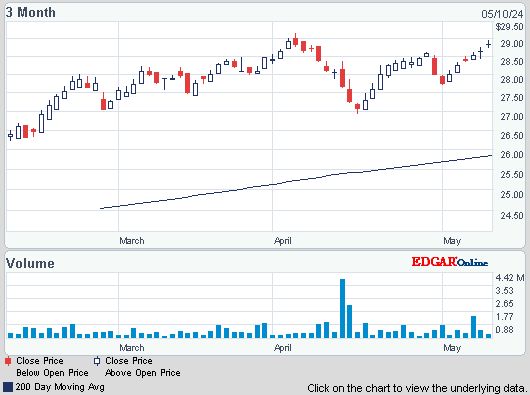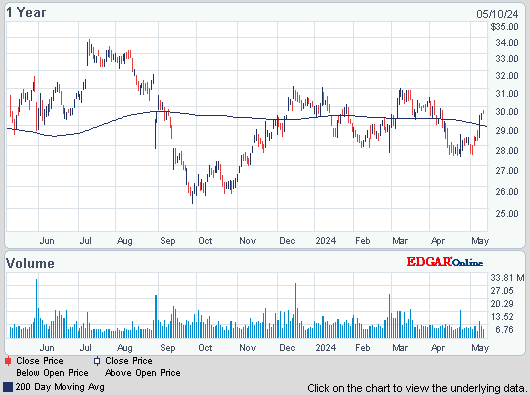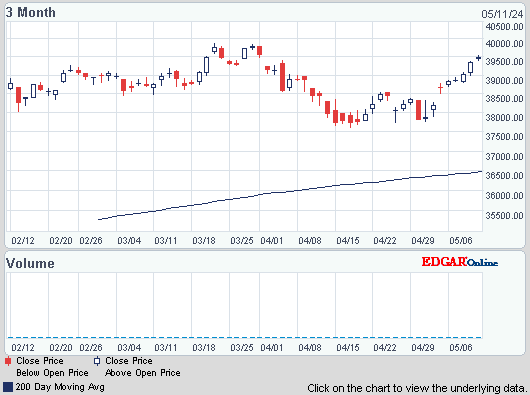Dow rose 45, advancers ahead of decliners 2-1 & NAZ gained 16. The MLP slipped a fraction to 460 & the REIT index was up a fraction to 283. Junk bond funds were mixed & Treasuries did little. Oil was about even & gold crawled higher.
AMJ (Alerian MLP Index tracking fund)

Sales of previously owned homes in the US dropped in Jan to the lowest level in more than a year as harsh winter weather combined with a lack of supply, tight credit & declining affordability slowed demand. Purchases decreased 5.1% to a 4.62M annual rate, according to the National Association of Realtors (NAR). The forecast projected sales would drop to a 4.67M rate. Sales fell in all 4 regions of the country. The figures reflect closings on contracts signed months earlier & highlight how higher borrowing costs & property prices have slowed momentum in residential real estate. More progress in the labor market that generates stronger wage growth would help reinvigorate demand. Compared with a year earlier, purchases decreased 5.1% in Jan & the median price for a home increased 10.7% from a year earlier to $189K. The NAR issued its annual revisions affecting data over the past 3 years. Sales totaled 5.09M in 2013, the same as previously estimated. The poor weather wasn’t completely to blame for the drop in activity,” Lawrence Yun, NAR chief economist, said. “Lack of inventory is clearly one of the factors. Buyers want to see more choices.” First-time buyers accounted for 26% of all purchases in Jan, the lowest since record keeping began in Oct 2008.
Sales of U.S. Existing Homes Slump to Lowest Since July 2012
Hewlett-Packard reported fiscal Q1 sales & profit that topped estimates as the PC maker won new orders for corp machines & servers to run data centers. EPS excluding certain costs was 90¢ on revenue of $28.2B, beating the prediction profit of 84¢ & revenue of $27.2B. CEO Meg Whitman is trying to reshape the company, which is headed for a 3rd straight annual sales decline as the PC market shrinks. “The restructuring program is very much on track and customers and partners have a lot more confidence in HP than they did two and a half years ago,” Whitman said. Q1 EPS was 74¢, up from 63¢ a year earlier. Revenue slipped less than 1% from the $28.4B in the year-ago period. EPS before certain costs in Q2 will be 85-89¢ which compares with the estimate for 89¢. PC shipments fell for a 7th straight qtr, dropping 6.9%, as consumers continued to choose smartphones & tablets over laptops, according to researcher Gartner. HPQ had the #2 worldwide spot by unit sales, with 16.4% of the market, even as its shipments dropped 7.2% from a year earlier. Fiscal Q1 revenue in the personal-systems unit, which includes PCs, rose 3.6% to $8.53B, boosted by sales of business computers. Printing-division sales dropped 2.2% to $5.82B. In the PC market, “the rate of decline is slowing,” Whitman said. “Commercial notebooks was a real bright spot.” The stock fell 53¢.
Hewlett-Packard Revenue Tops Estimates on Server Demand


Photo: Bloomberg
The G-20 will take “concrete actions” to bolster growth while backing the normalization of monetary policy in advanced economies, according to a draft communique. “We commit to developing new measures to significantly raise global growth, while maintaining fiscal sustainability,” the draft for this weekend’s meeting of G-20 finance ministers & central bankers in Sydney says. “We recognize accommodative monetary policy settings in advanced economies will need to normalize in due course, in line with stronger growth.” Australia is pushing for a growth target, an idea that’s met with support from the IMF & the UK & skepticism from Grermany. The draft cites analysis that ambitious policies could raise collective GDP by “at least 2 percent” above the trajectory implied by current settings over 5 years. Emerging markets have complained that the Federal Reserve hasn’t paid enough attention to the intl fallout from its decision to taper bond buying. Emerging-market stocks & currencies have fallen since the pullback was announced in Dec as investors turned more risk averse & punished economies with flaws such as large current-account deficits or political discord. The results of the meeting will be the same as prior meetings, a lot of hot air.
Dow is up 178 this week & has risen 465 (3%) in Feb. This is not bad considering there has been a fair number of unpleasant news stories. The weather in the US has been very bad which will hurt Q1 results. Intl news has not been good although it looks like warring factions in the Ukraine have arrived at a truce (of sorts). But stocks were oversold after the plunge in Jan & bargain hunters are buying. Dow remains down 400+ YTD.
Dow Jones Industrials

AMJ (Alerian MLP Index tracking fund)
Treasursy yields:
U.S. 3-month |
0.04% | |
U.S. 2-year |
0.32% | |
U.S. 10-year |
2.75% |
| CLJ14.NYM | .....Crude Oil Apr 14 | ...102.55 | (0.2%) |
| GCG14.CMX | ...Gold Feb 14 | ........1,323.70 | (0.5%) |
Sales of previously owned homes in the US dropped in Jan to the lowest level in more than a year as harsh winter weather combined with a lack of supply, tight credit & declining affordability slowed demand. Purchases decreased 5.1% to a 4.62M annual rate, according to the National Association of Realtors (NAR). The forecast projected sales would drop to a 4.67M rate. Sales fell in all 4 regions of the country. The figures reflect closings on contracts signed months earlier & highlight how higher borrowing costs & property prices have slowed momentum in residential real estate. More progress in the labor market that generates stronger wage growth would help reinvigorate demand. Compared with a year earlier, purchases decreased 5.1% in Jan & the median price for a home increased 10.7% from a year earlier to $189K. The NAR issued its annual revisions affecting data over the past 3 years. Sales totaled 5.09M in 2013, the same as previously estimated. The poor weather wasn’t completely to blame for the drop in activity,” Lawrence Yun, NAR chief economist, said. “Lack of inventory is clearly one of the factors. Buyers want to see more choices.” First-time buyers accounted for 26% of all purchases in Jan, the lowest since record keeping began in Oct 2008.
Sales of U.S. Existing Homes Slump to Lowest Since July 2012
Hewlett-Packard reported fiscal Q1 sales & profit that topped estimates as the PC maker won new orders for corp machines & servers to run data centers. EPS excluding certain costs was 90¢ on revenue of $28.2B, beating the prediction profit of 84¢ & revenue of $27.2B. CEO Meg Whitman is trying to reshape the company, which is headed for a 3rd straight annual sales decline as the PC market shrinks. “The restructuring program is very much on track and customers and partners have a lot more confidence in HP than they did two and a half years ago,” Whitman said. Q1 EPS was 74¢, up from 63¢ a year earlier. Revenue slipped less than 1% from the $28.4B in the year-ago period. EPS before certain costs in Q2 will be 85-89¢ which compares with the estimate for 89¢. PC shipments fell for a 7th straight qtr, dropping 6.9%, as consumers continued to choose smartphones & tablets over laptops, according to researcher Gartner. HPQ had the #2 worldwide spot by unit sales, with 16.4% of the market, even as its shipments dropped 7.2% from a year earlier. Fiscal Q1 revenue in the personal-systems unit, which includes PCs, rose 3.6% to $8.53B, boosted by sales of business computers. Printing-division sales dropped 2.2% to $5.82B. In the PC market, “the rate of decline is slowing,” Whitman said. “Commercial notebooks was a real bright spot.” The stock fell 53¢.
Hewlett-Packard Revenue Tops Estimates on Server Demand
Hewlett-Packard (HPQ)

Photo: Bloomberg
The G-20 will take “concrete actions” to bolster growth while backing the normalization of monetary policy in advanced economies, according to a draft communique. “We commit to developing new measures to significantly raise global growth, while maintaining fiscal sustainability,” the draft for this weekend’s meeting of G-20 finance ministers & central bankers in Sydney says. “We recognize accommodative monetary policy settings in advanced economies will need to normalize in due course, in line with stronger growth.” Australia is pushing for a growth target, an idea that’s met with support from the IMF & the UK & skepticism from Grermany. The draft cites analysis that ambitious policies could raise collective GDP by “at least 2 percent” above the trajectory implied by current settings over 5 years. Emerging markets have complained that the Federal Reserve hasn’t paid enough attention to the intl fallout from its decision to taper bond buying. Emerging-market stocks & currencies have fallen since the pullback was announced in Dec as investors turned more risk averse & punished economies with flaws such as large current-account deficits or political discord. The results of the meeting will be the same as prior meetings, a lot of hot air.
Dow is up 178 this week & has risen 465 (3%) in Feb. This is not bad considering there has been a fair number of unpleasant news stories. The weather in the US has been very bad which will hurt Q1 results. Intl news has not been good although it looks like warring factions in the Ukraine have arrived at a truce (of sorts). But stocks were oversold after the plunge in Jan & bargain hunters are buying. Dow remains down 400+ YTD.
Dow Jones Industrials










No comments:
Post a Comment